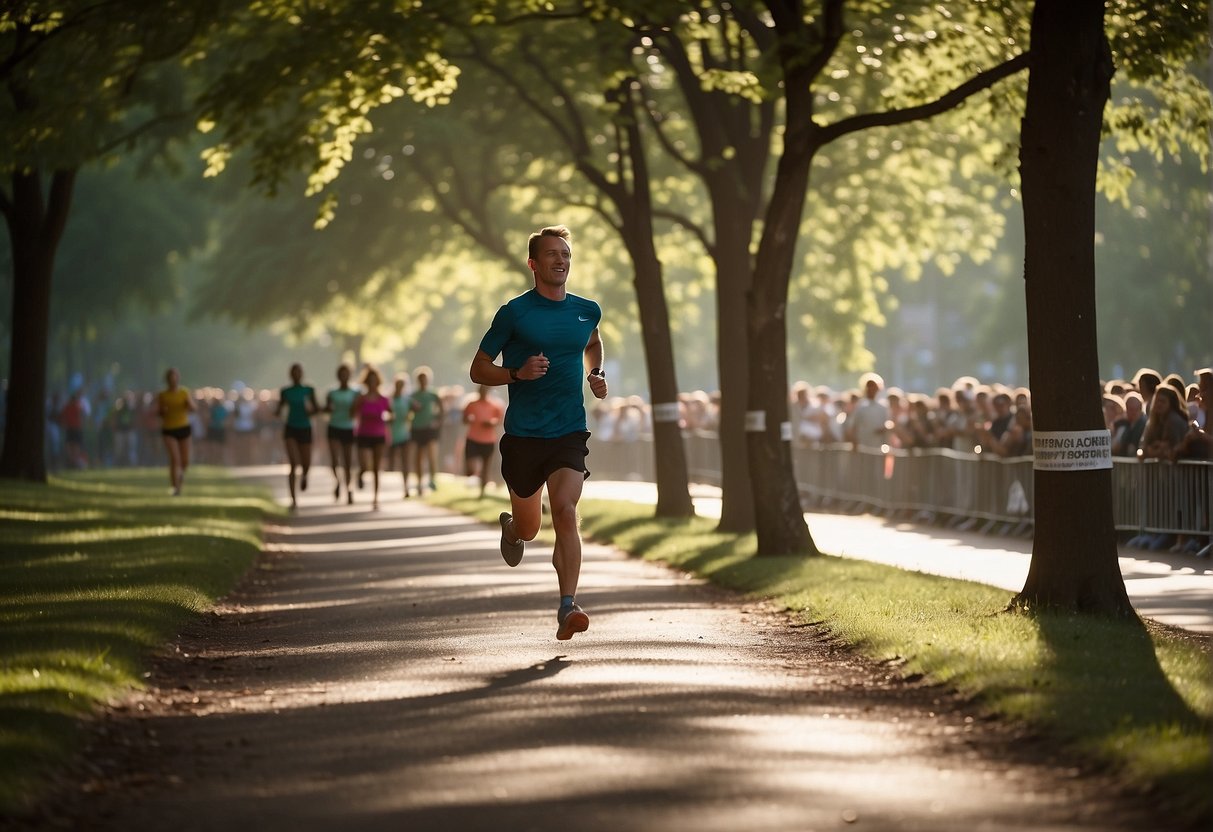For new runners and those looking to start racing, a common question is how to run a 5K without stopping. It is an achievable goal that can be a significant milestone in your running journey.
As a beginner, running over three miles continuously may seem daunting. However, with the right approach and preparation, you can build the endurance and confidence needed to cross the finish line without a walking break.
Establishing a solid foundation in running takes consistency and patience, but the sense of accomplishment you’ll feel after completing a 5K is immeasurable.

Training for a non-stop 5K requires a plan tailored to your fitness level.
Beginning with running and walking can help you gradually increase your stamina. Over time, this strategy will bolster your aerobic capacity and allow you to extend the distance you can run without taking breaks.
Learning and applying proper nutrition, hydration techniques, and injury prevention methods are also pivotal to steady progress.
As race day approaches, having a clear and tested strategy will give you the confidence to tackle the distance head-on and celebrate a personal victory.
Key Takeaways
- Gradual training increases endurance for a non-stop 5K.
- Proper preparation encompasses nutrition and injury prevention.
- A tested race day strategy provides the confidence to succeed.
Quick Navigation
How to Run a 5k Without Stopping: Setting the Foundation

You must have a strong foundation in gearing up to run a 5K without stopping. Starting with solid basics, identifying your current capabilities, and progressively enhancing your aerobic capacity will position you for success.
Understanding the Basics
You must comprehend what running a 5K entails and recognize the importance of consistent training.
A good grasp of running form can save you from injury and make your runs more efficient. It’s good news that the basics of running are straightforward and can be adopted by anyone willing to learn.
Establishing a Starting Point
Determining your starting point is vital. It involves honestly assessing your current level of cardiovascular fitness and running ability.
You might be a beginner or someone who’s been active for a long time but never ran consistently. Record your initial stats to track improvement.
Building Aerobic Capacity
You must bolster your aerobic capacity to run a 5K without stopping.
This means gradually increasing the time you spend running comfortably to improve endurance.
Start with intervals of walking and jogging, then increase the running portion as your body adapts. A solid base in aerobic exercise will carry you across the finish line.
How to Run a 5k Without Stopping: Designing Your Training Plan

A successful training plan is crucial for running a 5K without stopping. Your plan will incorporate interval training to boost endurance, long runs to build stamina, and rest days to allow for recovery.
Incorporating Interval Training
Interval training is essential to improving your cardiovascular fitness.
Regularly including intervals in your training schedule can enhance your ability to maintain a steady pace during a 5K run.
Begin with short running intervals followed by walking breaks. For example, start with 5-minute running intervals at an easy pace, gradually reducing the walking time as your fitness improves.
The Role of Long Runs
Long runs are the cornerstone of any best training plan. They condition your body to endure the sustained effort of covering a 5K distance.
Schedule a long run once a week and aim to extend your running time slowly. This doesn’t mean running at full speed; rather, focus on maintaining a consistent, easy pace that allows you to complete the distance comfortably.
Balancing Running and Rest Days
Your body needs time to recover from the stresses of training runs.
Be sure to include rest days in your training schedule. This helps prevent injury and aids in your body’s recovery process.
Striking the right balance between activity and rest ensures you’re always ready for your next run.
Plan rest days strategically—after a long run or a high-intensity interval session, for instance—to maximize your training gains on a regular basis.
How to Run a 5k Without Stopping: Nutrition and Hydration

Proper nutrition and hydration are pivotal to running a 5K without stopping. Ensuring you consume the right foods and maintain fluid balance helps optimize your energy levels and performance.
Fueling Your Runs
Best foods for energy: Start your day with simple and complex carbohydrates to sustain your energy throughout the run.
Foods like oatmeal with a tablespoon of peanut butter can provide a stable release of energy. Include a variety of fruits, vegetables, whole grains, and lean proteins in your diet to keep your nutrient intake balanced.
Example Meal Plan:
- Breakfast: Oatmeal with peanut butter and sliced banana.
- Snack: Greek yogurt with mixed berries.
- Lunch: Quinoa salad with mixed greens, roasted chickpeas, and sliced avocado.
- Dinner: Grilled chicken with sweet potatoes and steamed broccoli.
Staying Hydrated During Training
Ensuring you’re well-hydrated is crucial for maintaining your performance during a 5K run.
Hydration before the run: Drink at least 16 ounces of water 2 hours before your 5K to ensure you’re well-hydrated.
Hydration during the run: Carry a small bottle with you if you’re out for longer than 30 minutes. Sip on water or a sports drink to replenish electrolytes, aiming for about 8 ounces every 20 minutes.
Remember: The frequency and amount of hydration may vary based on individual needs and conditions, so listen to your body’s signals.
How to Run a 5k Without Stopping: Preventing Injuries

Preparing for a 5K run without stopping necessitates a two-pronged approach to injury prevention: incorporating strength training tailored to running and refining your running techniques. These strategies aim to reduce the risk of injury and enhance your running performance.
Importance of Strength Training
Strength training is not just about bulking up; it’s about building a solid foundation that supports your joints and improves muscle endurance.
Integrating strength workouts into your routine can contribute significantly to injury prevention and overall running performance.
Focus on exercises that target key muscle groups used in running, such as your glutes, quadriceps, hamstrings, and calves. Dynamic stretches can help warm up these muscles before you run, while static stretches afterward may aid recovery.
- Dynamic stretches to include:
- Leg swings
- Walking lunges
- Static stretches to include post-run:
- Hamstring stretch
- Calf stretch
Adopting Proper Running Techniques
Your running form plays a critical role in minimizing stress on your body.
Pay attention to your posture, ensuring that you maintain a neutral spine and avoid overstriding, which could lead to injuries like a runner’s knee.
Additionally, try to run on forgiving surfaces and wear appropriate footwear that offers sufficient support and cushioning for your feet.
How to Run a 5k Without Stopping: Race Day Preparation

Proper preparation for race day is key to running your 5K without stopping. You’ll need to strategize your run, manage your pacing and hydration, and ensure mental readiness for the challenges ahead.
Strategizing Your Run
Develop a strategy for your run that breaks the course into manageable segments.
Study the course map to identify any potential tough spots, like hills, where you need to conserve energy. Confirm the start time of your race and plan to arrive early so that unexpected delays won’t disrupt your focus.
Pacing and Hydration
Begin the race at a steady pace that you can maintain until the finish line. Avoid starting too fast, which can lead to early fatigue.
Drink water to maintain hydration, but balance your intake to avoid discomfort.
A general guideline is to take a few sips of water every 15-20 minutes, adjusting based on the weather and your sweat rate.
Mental Readiness
Mentally prepare by visualizing the race from start to finish. Take deep breaths to calm your nerves and focus your mind.
Maintain a positive inner dialogue and remind yourself of your training.
Keep your energy levels steady through mental encouragement, especially when the run becomes challenging.
How to Run a 5k Without Stopping: Advanced Techniques

To run a 5K without stopping, integrating advanced techniques into your training can make a significant difference.
Focusing on speed and tempo workouts, hill training, and resistance exercises will enhance your strength and endurance.
Speed and Tempo Workouts
Tempo runs are critical for improving your lactate threshold, teaching your body to sustain speed over distance. Here’s how to structure them:
- Warm-up: Start with 10-15 minutes of easy jogging.
- Tempo Pace: Run at a challenging but manageable pace for 20 minutes.
- Cool down: Finish with a 5-10 minute jog to help your muscles recover.
Incorporating weekly speed training sessions is also beneficial. These can consist of:
- Intervals: Run fast for a set distance, then recover with slow jogging or walking before repeating.
- Repetitions: Shorter than intervals, focusing on speed and more recovery time.
Hill Training and Resistance
To build power and improve the running economy, include hill training in your routine. Here’s a simple hill workout:
- Find a Hill: Choose a hill that takes about 60 seconds to run up.
- Hill Repeats: After warming up, run up the hill at a hard but sustainable effort, then jog or walk down for recovery.
- Frequency: Perform this workout once a week, gradually increasing the number of repetitions.
Additionally, integrate resistance training to strengthen muscles and joints:
-
- Free Weights and Machines: Focus on lower body strength twice a week.
- Bodyweight Exercises: Include squats, lunges, and calf raises.
How to Run a 5k Without Stopping: Monitoring Your Progress

When training for a 5K without stopping, keeping track of your progress is crucial. These are some methods to ensure you are on the right path:
-
-
- Heart Rate: Monitor your heart rate during training. A heart rate within your targeted zone indicates you’re pushing hard enough but not overexerting.
- First Mile: Gauge your comfort with the first mile. It sets the pace for the remaining distance and should feel manageable, not exhausting.
- Longer Distances: Gradually increase your running distance. Each week, strive to run a bit farther, building stamina and confidence.
- Time Trial: Periodically conduct a time trial on a route similar to your 5K. Record your time and use it to measure improvement.
- Easy Runs: Incorporate easy runs into your plan. They help you recover and maintain your base without additional stress.
-
You’ll gain insights into your training efficacy by systematically documenting these variables.
Use a simple table like the one below to track key metrics weekly:
| Week | Heart Rate | First Mile Comfort | Longest Run Distance | Time Trial Result | Easy Run Observations |
|---|---|---|---|---|---|
| 1 | 150 bpm | Challenging | 2 miles | – | Light and refreshing |
| 2 | 145 bpm | Moderate | 2.5 miles | – | Steady pace maintained |
| … | … | … | … | … | … |
How to Run a 5k Without Stopping: Staying Motivated

Maintaining your motivation is key to running a 5K without stopping. Joining a community or setting achievable, incremental objectives helps turn your training into a rewarding journey.
Joining a Running Group or Club
Joining a running group or club can exponentially boost your motivation.
Training with others provides a sense of community and accountability. You’re more likely to show up for training when you know your running mates are expecting you.
Run clubs often cater to various levels and have coaches to provide guidance, which can be particularly helpful when starting.
Setting New Goals
Creating and striving for new goals keeps your training focused and exciting.
Start with smaller, reachable targets that lead up to your main goal of completing a 5K without stopping.
For instance, you might aim to improve your time on a familiar route or extend the distance you can run without a break.
Set good examples for yourself by recognizing achievements like consistently completing training sessions or surpassing a personal record.
Sharing your objectives with family members or friends can also add a layer of commitment and motivation.
How to Run a 5k Without Stopping: Conclusion
Learning how to run a 5K without stopping is a journey combining dedication, proper training, and a focus on physical and mental preparation.
From establishing a solid foundation with the right running form and aerobic capacity to designing a personalized training plan that includes interval training, long runs, and adequate rest, every step you take brings you closer to your goal.
Nutrition and hydration are critical in fueling your body and maintaining energy levels, while injury prevention techniques ensure you stay healthy and on track. As race day approaches, having a clear strategy, managing your pacing, and staying mentally strong will empower you to cross the finish line with pride.
Remember, the key to how to run a 5K without stopping lies not just in the physical preparation but in the commitment to a goal that might once have seemed out of reach. Celebrate each milestone, from your first uninterrupted mile to the completion of your first 5K, as a testament to your hard work and perseverance.
Whether you’re a beginner or looking to improve your running endurance, the journey to running a 5K without stopping is a rewarding experience that builds physical strength, confidence, and a sense of achievement.
Embrace the challenge, enjoy the process, and let the goal of running a 5K without stopping inspire you to push beyond your limits. With the right approach, that finish line isn’t just a destination; it’s a starting point for new challenges and achievements in your running journey.


